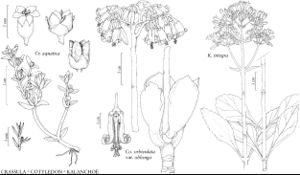Difference between revisions of "Cotyledon"
Sp. Pl. 1: 429. 1753.
Gen. Pl. ed. 5., 196. 1754, name conserved ,.
FNA>Volume Importer |
imported>Volume Importer |
||
| Line 24: | Line 24: | ||
-->{{Treatment/Body | -->{{Treatment/Body | ||
|distribution=Calif.;Asia (sw Arabia);s;e Africa. | |distribution=Calif.;Asia (sw Arabia);s;e Africa. | ||
| + | |introduced=true | ||
|discussion=<p>Species 11 (1 in the flora).</p><!-- | |discussion=<p>Species 11 (1 in the flora).</p><!-- | ||
--><p>A. P. de Candolle (1828) narrowed <i>Cotyledon</i> to a natural group of African plants, for which C. H. Uhl (1948) found a distinctive karyotype, with x = 9 rather large chromosomes. H. R. Toelken (1985) further recognized two segregates, Adromischus Lemaire and Tylocodon Toelken, not in the flora area.</p> | --><p>A. P. de Candolle (1828) narrowed <i>Cotyledon</i> to a natural group of African plants, for which C. H. Uhl (1948) found a distinctive karyotype, with x = 9 rather large chromosomes. H. R. Toelken (1985) further recognized two segregates, Adromischus Lemaire and Tylocodon Toelken, not in the flora area.</p> | ||
| Line 47: | Line 48: | ||
|publication year=1753; | |publication year=1753; | ||
|special status= | |special status= | ||
| − | |source xml=https:// | + | |source xml=https://bibilujan@bitbucket.org/aafc-mbb/fna-data-curation.git/src/bb6b7e3a7de7d3b7888a1ad48c7fd8f5c722d8d6/coarse_grained_fna_xml/V8/V8_312.xml |
|genus=Cotyledon | |genus=Cotyledon | ||
}}<!-- | }}<!-- | ||
-->[[Category:Treatment]][[Category:Crassulaceae]] | -->[[Category:Treatment]][[Category:Crassulaceae]] | ||
Revision as of 01:10, 28 May 2020
Shrubs, not viviparous, to 8 dm, glabrous [pubescent]. Stems erect, branching, fleshy but somewhat woody. Leaves persistent, cauline, opposite, sessile, not connate basally; blade obovate, laminar, 5–18 cm, fleshy, base not spurred, margins entire; veins not conspicuous. Inflorescences terminal cymes, ultimate branches uniparous. Pedicels present. Flowers pendulous, 5-merous; sepals connate basally, all alike; petals basally erect, distally spreading, connate into 5-gonal tube, orange [red or yellow]; calyx and corolla circumscissile at base in fruit; nectaries adnate to pistils forming cup; stamens 10; filaments adnate to corolla; pistils erect; ovary base rounded; styles longer than or equaling ovary. Fruits erect. Seeds ellipsoid, few-ribbed, finely cross-ribbed. x = 9.
Distribution
Introduced; Calif., Asia (sw Arabia), s, e Africa.
Discussion
Species 11 (1 in the flora).
A. P. de Candolle (1828) narrowed Cotyledon to a natural group of African plants, for which C. H. Uhl (1948) found a distinctive karyotype, with x = 9 rather large chromosomes. H. R. Toelken (1985) further recognized two segregates, Adromischus Lemaire and Tylocodon Toelken, not in the flora area.
Selected References
None.
